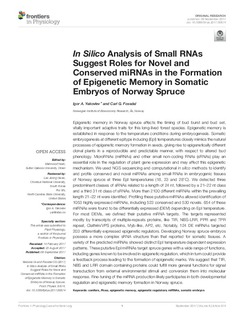| dc.contributor.author | Yakovlev, Igor | |
| dc.contributor.author | Fossdal, Carl Gunnar | |
| dc.date.accessioned | 2018-03-06T11:14:57Z | |
| dc.date.available | 2018-03-06T11:14:57Z | |
| dc.date.created | 2017-09-08T09:50:11Z | |
| dc.date.issued | 2017-09-08 | |
| dc.identifier.citation | Frontiers in Physiology. 2017, 8 1-17. | nb_NO |
| dc.identifier.issn | 1664-042X | |
| dc.identifier.uri | http://hdl.handle.net/11250/2488851 | |
| dc.description.abstract | Epigenetic memory in Norway spruce affects the timing of bud burst and bud set, vitally important adaptive traits for this long-lived forest species. Epigenetic memory is established in response to the temperature conditions during embryogenesis. Somatic embryogenesis at different epitype inducing (EpI) temperatures closely mimics the natural processes of epigenetic memory formation in seeds, giving rise to epigenetically different clonal plants in a reproducible and predictable manner, with respect to altered bud phenology. MicroRNAs (miRNAs) and other small non-coding RNAs (sRNAs) play an essential role in the regulation of plant gene expression and may affect this epigenetic mechanism. We used NGS sequencing and computational in silico methods to identify and profile conserved and novel miRNAs among small RNAs in embryogenic tissues of Norway spruce at three EpI temperatures (18, 23 and 28◦C). We detected three predominant classes of sRNAs related to a length of 24 nt, followed by a 21–22 nt class and a third 31 nt class of sRNAs. More than 2100 different miRNAs within the prevailing length 21–22 nt were identified. Profiling these putative miRNAs allowed identification of 1053 highly expressed miRNAs, including 523 conserved and 530 novels. 654 of these miRNAs were found to be differentially expressed (DEM) depending on EpI temperature. For most DEMs, we defined their putative mRNA targets. The targets represented mostly by transcripts of multiple-repeats proteins, like TIR, NBS-LRR, PPR and TPR repeat, Clathrin/VPS proteins, Myb-like, AP2, etc. Notably, 124 DE miRNAs targeted 203 differentially expressed epigenetic regulators. Developing Norway spruce embryos possess a more complex sRNA structure than that reported for somatic tissues. A variety of the predicted miRNAs showed distinct EpI temperature dependent expression patterns. These putative EpI miRNAs target spruce genes with a wide range of functions, including genes known to be involved in epigenetic regulation, which in turn could provide a feedback process leading to the formation of epigenetic marks. We suggest that TIR, NBS and LRR domain containing proteins could fulfill more general functions for signal transduction from external environmental stimuli and conversion them into molecular response. Fine-tuning of the miRNA production likely participates in both developmental regulation and epigenetic memory formation in Norway spruce. | nb_NO |
| dc.language.iso | eng | nb_NO |
| dc.publisher | Frontiers Media | nb_NO |
| dc.rights | Navngivelse 4.0 Internasjonal | * |
| dc.rights.uri | http://creativecommons.org/licenses/by/4.0/deed.no | * |
| dc.subject | conifers | nb_NO |
| dc.subject | Picea | nb_NO |
| dc.subject | epigenetic memory | nb_NO |
| dc.subject | epigenetic regulators | nb_NO |
| dc.subject | miRNAs | nb_NO |
| dc.subject | somatic embryos | nb_NO |
| dc.title | In Silico Analysis of Small RNAs Suggest Roles for Novel and Conserved miRNAs in the Formation of Epigenetic Memory in Somatic Embryos of Norway Spruce | nb_NO |
| dc.type | Journal article | nb_NO |
| dc.type | Peer reviewed | nb_NO |
| dc.description.version | publishedVersion | nb_NO |
| dc.rights.holder | © 2017 Yakovlev and Fossdal. This is an open-access article distributed under the terms of the Creative Commons Attribution License (CC BY). The use, distribution or reproduction in other forums is permitted, provided the original author(s) or licensor are credited and that the original publication in this journal is cited, in accordance with accepted academic practice. No use, distribution or reproduction is permitted which does not comply with these terms. | nb_NO |
| dc.source.pagenumber | 1-17 | nb_NO |
| dc.source.volume | 8 | nb_NO |
| dc.source.journal | Frontiers in Physiology | nb_NO |
| dc.identifier.doi | 10.3389/fphys.2017.00674 | |
| dc.identifier.cristin | 1491987 | |
| dc.relation.project | Norges forskningsråd: 191455 | nb_NO |
| dc.relation.project | Norges forskningsråd: 191455/V40 | nb_NO |
| dc.relation.project | Norges forskningsråd: 249958 | nb_NO |
| dc.relation.project | Norges forskningsråd: 240766/F20 | nb_NO |
| dc.relation.project | Norges forskningsråd: 240766 | nb_NO |
| cristin.ispublished | true | |
| cristin.fulltext | original | |
| cristin.qualitycode | 1 | |

